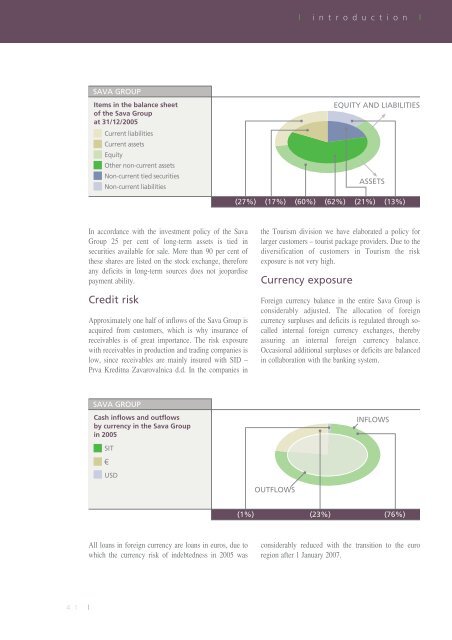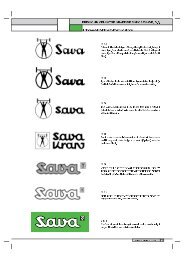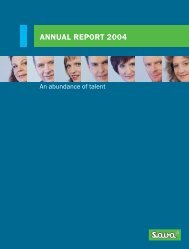Annual report 2005 - Sava dd
Annual report 2005 - Sava dd
Annual report 2005 - Sava dd
You also want an ePaper? Increase the reach of your titles
YUMPU automatically turns print PDFs into web optimized ePapers that Google loves.
4 1 |<br />
SAVA GROUP<br />
Items in the balance sheet<br />
of the <strong>Sava</strong> Group<br />
at 31/12/<strong>2005</strong><br />
Current liabilities<br />
Current assets<br />
Equity<br />
Other non-current assets<br />
Non-current tied securities<br />
Non-current liabilities<br />
In accordance with the investment policy of the <strong>Sava</strong><br />
Group 25 per cent of long-term assets is tied in<br />
securities available for sale. More than 90 per cent of<br />
these shares are listed on the stock exchange, therefore<br />
any deficits in long-term sources does not jeopardise<br />
payment ability.<br />
Credit risk<br />
(27%)<br />
Approximately one half of inflows of the <strong>Sava</strong> Group is<br />
acquired from customers, which is why insurance of<br />
receivables is of great importance. The risk exposure<br />
with receivables in production and trading companies is<br />
low, since receivables are mainly insured with SID –<br />
Prva Kreditna Zavarovalnica d.d. In the companies in<br />
SAVA GROUP<br />
Cash inflows and outflows<br />
by currency in the <strong>Sava</strong> Group<br />
in <strong>2005</strong><br />
(1%)<br />
All loans in foreign currency are loans in euros, due to<br />
which the currency risk of indebtedness in <strong>2005</strong> was<br />
| i n t r o d u c t i o n |<br />
(17%) (60%) (62%) (21%) (13%)<br />
the Tourism division we have elaborated a policy for<br />
larger customers – tourist package providers. Due to the<br />
diversification of customers in Tourism the risk<br />
exposure is not very high.<br />
Currency exposure<br />
EQUITY AND LIABILITIES<br />
ASSETS<br />
Foreign currency balance in the entire <strong>Sava</strong> Group is<br />
considerably adjusted. The allocation of foreign<br />
currency surpluses and deficits is regulated through socalled<br />
internal foreign currency exchanges, thereby<br />
assuring an internal foreign currency balance.<br />
Occasional a<strong>dd</strong>itional surpluses or deficits are balanced<br />
in collaboration with the banking system.<br />
OUTFLOWS<br />
INFLOWS<br />
(23%) (76%)<br />
considerably reduced with the transition to the euro<br />
region after 1January 2007.








